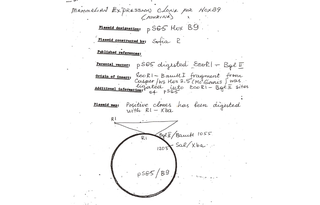HOXB9 (murine) pSG5
(Plasmid
#8542)
-
Depositing Lab
-
Publication
-
Sequence Information
-
Please contact us if you would like Addgene to sequence a portion of this plasmid before you request it.
-
Full plasmid sequence is not available for this item.
Ordering
| Item | Catalog # | Description | Quantity | Price (USD) | |
|---|---|---|---|---|---|
| Plasmid | 8542 | Standard format: Plasmid sent in bacteria as agar stab | 1 | $85 | |
Backbone
-
Vector backbonepSG5
-
Backbone manufacturerStratagene
-
Vector typeMammalian Expression
Growth in Bacteria
-
Bacterial Resistance(s)Ampicillin, 100 μg/mL
-
Growth Temperature37°C
-
Growth Strain(s)DH5alpha
-
Copy numberUnknown
Gene/Insert
-
Gene/Insert nameHOXB9
-
Alt nameHOX2E
-
Alt nameHOX2.5
-
SpeciesM. musculus (mouse)
-
Insert Size (bp)1000
-
MutationContains cDNA encoding 11 amio acids from the 5'untranslated region preceeding the ATG start
-
GenBank IDM34857
-
Entrez GeneHoxb9 (a.k.a. Hox-2.5)
-
Tags
/ Fusion Proteins
- T7 (N terminal on backbone)
- His (N terminal on backbone)
Cloning Information
- Cloning method Restriction Enzyme
- 5′ cloning site EcoRI (not destroyed)
- 3′ cloning site BamHI/BglII blunt (destroyed during cloning)
- 5′ sequencing primer T7 (Common Sequencing Primers)
Resource Information
-
A portion of this plasmid was derived from a plasmid made byWilliam McGinnis
Terms and Licenses
-
Academic/Nonprofit Terms
-
Industry Terms
- Not Available to Industry
Trademarks:
- Zeocin® is an InvivoGen trademark.
These plasmids were created by your colleagues. Please acknowledge the Principal Investigator, cite the article in which the plasmids were described, and include Addgene in the Materials and Methods of your future publications.
-
For your Materials & Methods section:
HOXB9 (murine) pSG5 was a gift from Corey Largman (Addgene plasmid # 8542) -
For your References section:
Pbx modulation of Hox homeodomain amino-terminal arms establishes different DNA-binding specificities across the Hox locus. Chang CP, Brocchieri L, Shen WF, Largman C, Cleary ML. Mol Cell Biol 1996 Apr;16(4):1734-45. PubMed 8657149
Map uploaded by the depositor.



